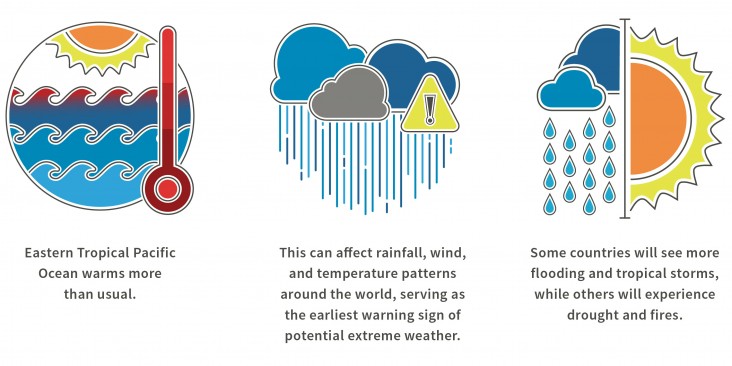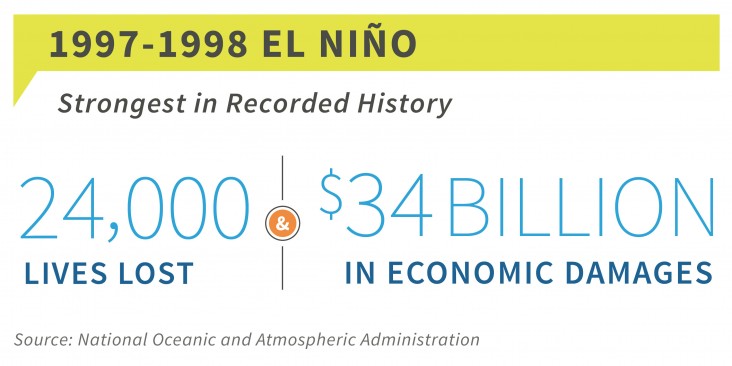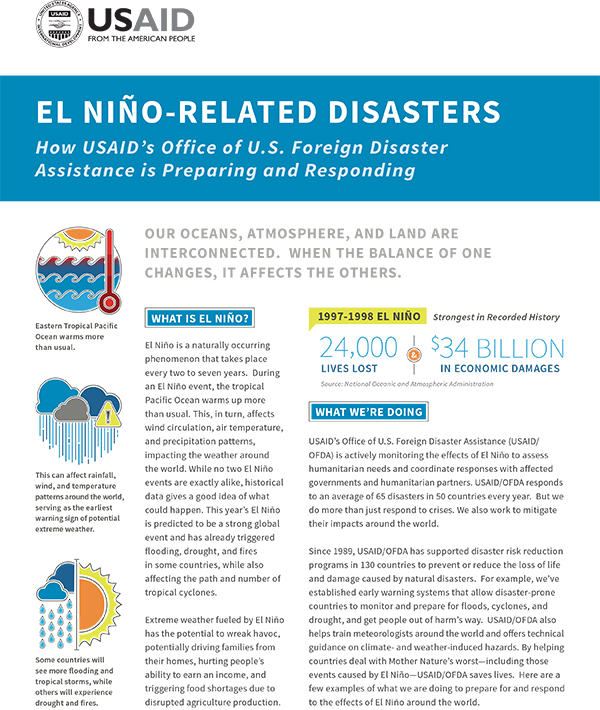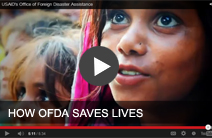- What We Do
- Agriculture and Food Security
- Democracy, Human Rights and Governance
- Economic Growth and Trade
- Education
- Ending Extreme Poverty
- Environment and Global Climate Change
- Gender Equality and Women's Empowerment
- Global Health
- Water and Sanitation
- Working in Crises and Conflict
- Disaster Assistance
- Political Transition Initiatives
- Conflict Mitigation and Prevention
- Countering Violent Extremism
- Disaster Risk Reduction
- Peacebuilding and Reconciliation
- Providing Safe & Secure Environments for Development
- Recovering From Crisis
- Resilience
- Tech Challenge for Atrocity Prevention
- World Humanitarian Day
- U.S. Global Development Lab

Our oceans, atmosphere, and land are interconnected. When the balance of one changes, it affects the others.
El Nino Fact Sheet 01-13-2016 ![]() (pdf - 861k)
(pdf - 861k)
El Nino Fact Sheet
What is El Niño?
El Niño is a naturally occurring phenomenon that takes place every two to seven years. During an El Niño event, the tropical Pacific Ocean warms up more than usual. This, in turn, affects wind circulation, air temperature, and precipitation patterns, impacting the weather around the world. While no two El Niño events are exactly alike, historical data gives a good idea of what could happen. This year’s El Niño is predicted to be a strong global event and has already triggered flooding, drought, and fires in some countries, while also affecting the path and number of tropical cyclones.
Extreme weather fueled by El Niño has the potential to wreak havoc, potentially driving families from their homes, hurting people’s ability to earn an income, and triggering food shortages due to disrupted agriculture production.

What We’re Doing
USAID’s Office of U.S. Foreign Disaster Assistance (USAID/OFDA) is actively monitoring the effects of El Niño to assess humanitarian needs and coordinate responses with affected governments and humanitarian partners. USAID/OFDA responds to an average of 65 disasters in 50 countries every year. But we do more than just respond to crises. We also work to mitigate their impacts around the world.
Since 1989, USAID/OFDA has supported disaster risk reduction programs in 130 countries to prevent or reduce the loss of life and damage caused by natural disasters. For example, we’ve established early warning systems that allow disaster-prone countries to monitor and prepare for floods, cyclones, and drought, and get people out of harm’s way. USAID/OFDA also helps train meteorologists around the world and offers technical guidance on climate- and weather-induced hazards. By helping countries deal with Mother Nature’s worst—including those events caused by El Niño—USAID/OFDA saves lives. Here are a few examples of what we are doing to prepare for and respond to the effects of El Niño around the world.
Drought
Papua New Guinea: El Niño-related drought has damaged crops and caused a shortage of safe drinking water, affecting an estimated 1.8 million people. Frost further impacted the food supply by killing much of the country’s staple sweet potato crop. In response, USAID/OFDA helped distribute seeds and plants to farmers and provided agricultural training on drought and frost resistant crops.
Guatemala: Low rainfall made worse by El Niño has led to drought and poor harvests. USAID/OFDA is helping communities cope by supporting activities such as soil conservation, rainwater harvesting, crop diversification, improved seed storage, and drip irrigation. We are also promoting village savings and loans programs to serve as a safety net to help families build up savings and negotiate interest rates.
Ethiopia: El Niño has exacerbated a severe drought following two poor harvests, leaving as many as 8 million people in need of emergency food assistance. USAID/OFDA can quickly scale up robust rapid response capabilities to provide safe drinking water, improved sanitation and hygiene, nutrition, and emergency relief supplies to hotspots across Ethiopia. Additionally, USAID’s Office of Food for Peace provided more than $120 million in assistance since July to help address the food needs of an estimated 3.5 million people, including those severely impacted by El Niño.
Flooding & Storms
Somalia: Potential flooding and drought triggered by El Niño will bring added devastation to the more than 3 million people already in need of humanitarian assistance by increasing food insecurity and causing more people to become sick from waterborne diseases like cholera, dengue, and malaria. USAID partners have developed contingency plans and pre-positioned relief supplies—such as food, hygiene kits and medical supplies—in areas expected to be impacted by floods. USAID/OFDA also supports ongoing activities to improve local authorities’ ability to prepare for disasters and give communities better access to disaster information.
Fires
Indonesia: Drought, worsened by El Niño, has made it difficult to fight fires raging across the country. The resulting toxic haze has spread throughout the region and caused more than 425,000 cases of acute respiratory infection. In response, USAID/OFDA provided funding for firefighting and safety equipment, face masks, and “clean air” shelters where respiratory sufferers can receive treatment. We also partnered with the U.S. Forest Service to send fire specialists to provide technical assistance on the operations and management of firefighting teams.
Colombia: Forest fires in Colombia have affected 12 of the country’s 32 provinces after effects from El Niño helped make parts of the country hotter and drier than normal. USAID/OFDA provided firefighting and communications equipment, as well as training on how to improve fire response coordination.









Comment
Make a general inquiry or suggest an improvement.